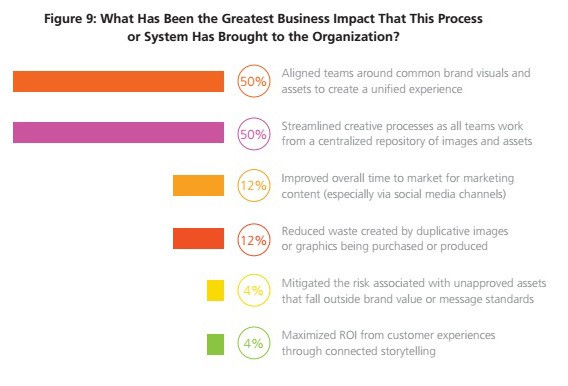A robust media library can help your brand have a big impact, especially if it’s well organized.
The majority of senior marketers say visual assets are key to telling their brand story. But only 27% of those people have a centralized way to organize those assets, according to our recent survey with the CMO Council. That means the importance of making sure an organization’s media library is well organized is often overlooked.
Not only is the disarray adding to your headache, it’s also costing you time, money and more.
1. You’re duplicating costs.
Departments aren’t sharing and repurposing content, and in the end, everyone loses. Let’s say someone on your admin team hired a professional photographer to snap a photo of your new building, but didn’t mention it to anyone. The public relations team might do the same and – BAM! – your organization paid for the same thing twice.
2. Photos and videos are getting lost in the shuffle.
When you don’t have a common system in place, your teams are storing photos in email inboxes and local drives. This can cause a huge problem when people delete emails, forget where they stored something, or leave the company. Remember that graphic designer who quit last month? What happened to all of the images stored on her computer?
3. You’re not keeping up with the speed of social media.
You’re missing opportunities to engage your audience because any time your topic is trending or news is breaking, it takes hours to find that perfect photo to Tweet. The conversation moves on without you. (We all know how it feels – you’re about to throw out the perfect joke. Then, someone jumps in ahead of you and steers the conversation off track! Now, your joke is irrelevant and you’re left wishing you had moved faster.)
4. Unknown usage rights block productivity.
If you don’t have an easy way to keep track of when you’re allowed to use an image and when you’re not, you’re stuck with a difficult choice. You could 1) take the risk and publish it anyway or 2) not publish it at all. Which do you choose? Trick question: the answer is neither! Get organized instead. If you consistently add metadata to your images noting when you can and can’t use them, you’ll avoid lawsuits and missed opportunities.
5. Your imagery is inconsistent.
Your customers should get a familiar feeling every time they interact with your brand. You don’t want your teams to publish photos and videos that all have a different look and feel. If you have a system in place to identify on-brand images in your library, your customers will get a cohesive and compelling story from all angles.
Here’s the good news. Senior marketers who have gotten organized say it pays off.

Marketers who set up systems to aggregate, catalogue and manage visual assets across their organizations cut costs, saved time, and made their creative teams’ work easier and faster.




